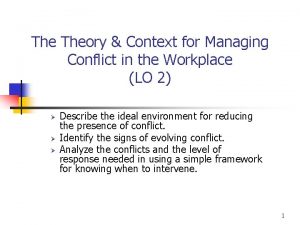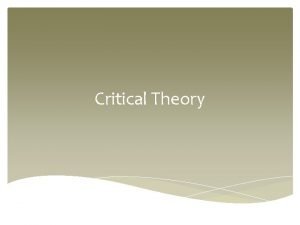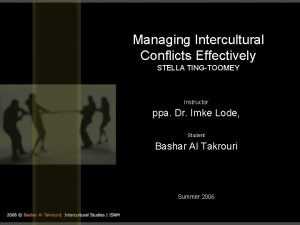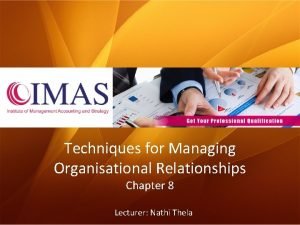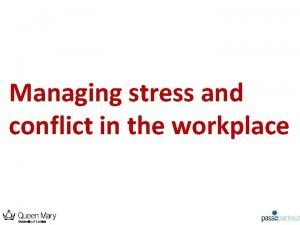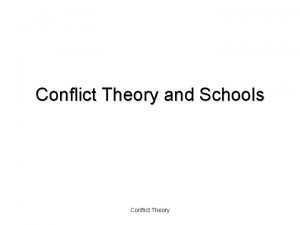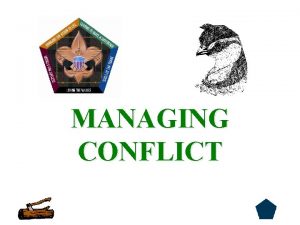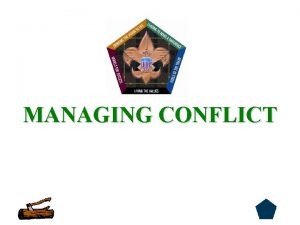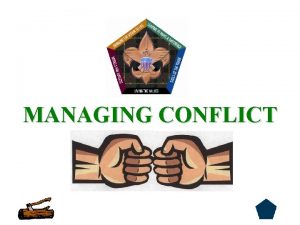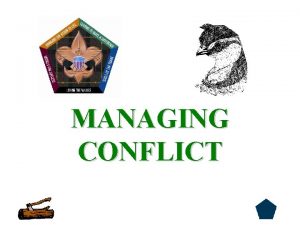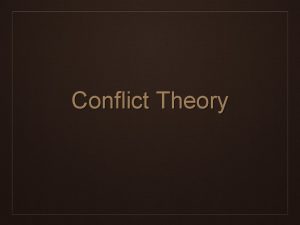The Theory Context for Managing Conflict in the
















- Slides: 16

The Theory & Context for Managing Conflict in the Workplace (LO 2) Ø Ø Ø Describe the ideal environment for reducing the presence of conflict. Identify the signs of evolving conflict. Analyze the conflicts and the level of response needed in using a simple framework for knowing when to intervene. 1

Environment of Minimal Conflict n n Conflict often is created when people feel they have no alternatives Hygiene-motivation theory – dissatisfied employees most often concerned about their environment (policies, administration, supervision, money, status, working conditions, security) (Fredrick Hertzberg) 2

Environment of Minimal Conflict n n Abraham Maslow Hierarchy of Needs Theory – basic needs must be met before higher needs pursued Physiological (survival) Safety and Security Acceptance Esteem Self-Actualization When an employee is unsuccessful in fulfilling these needs in the workplace – conflict likely will develop 3

Providing Meaningful Work n n Organizations must provide intrinsically valuable and meaningful work Motivation comes when employees find intrinsic value in their work Esteem needs – challenging assignments, variety, professional development, career growth, autonomy, and recognition Self-actualization – attaining one’s potential (See list on Exhibit 2. 2) 4

Paying Attention to Evolving Conflict n n Conflicts evolve when needs not met or interests are threatened Conflict inevitable even in the most progressive environment “thus”: n n Look for triggers to evolving conflict Respond appropriately before it escalates 5

Triggers n Over goals, policies, procedures: n n Employees efforts run contrary to team goals Policies/procedures threaten personal interests Employees disagree with team goals Employees do not trust the roles, goals, and expectations requested “What is in it for me? ” 6

Triggers n Over Information: n n n Lack information to do job or believe inaccuracies in the information Misunderstandings about the information Interpret the information differently 7

Triggers n Over Relationships: n n n Ability and comfort in communicating to group Different perceptions due to filters, experience, background, culture, etc. Differences because of race, ethnicity, gender, age, religion, sexual orientation, way people communicate, learn, work, social and economic status, job classification, duties, etc. 8

Triggers n Over Values: n n n Different values placed on work – intrinsic value, further interests, money Importance of getting to work on time, participating in meetings, team/alone Values concerning management authority, (defer/challenge) Evaluate other ideas/opinions (open or rigid) Values on lifestyle choices, ideology, politics, religion, and other deeply held beliefs 9

Triggers n Over Structures: n n Business structures creating time pressures, work overload, and stress Power imbalances causing feelings of disenfranchisement and powerlessness Lack of autonomy –disallowed or minimized and disincentives for taking control “Business as usual mentality” but more logical and effective ways exist to work 10

Monitoring the Work Environment n n n Know day-to-day happenings – connect with employees When a change is implemented – communicate openly/be ready to respond When sensing a rift – respond and support Sensitive to individuals who are having difficulties Stay in touch with customer needs/ complaints 11

Bumps, Bruises, and Head Bangers n Bumps Bruises Low. Head Bangers Moderate To High cy n e u q Fre High ity s ten In n Moderate Monitor Intervene immediately To High Confront Low to prevent escalation 12

Bumps (Monitor Stage) n n n Parties in disagreement but maintaining their relationship Most common part of a vibrant organization Monitor situation/mature parties often resolve issue Empowering individuals to address own situations is preferable Offer advice on how to confer 13

Bruises (Intervention Stage) n n n Evolving conflicts where intervention appropriate before further escalation Signs – party complaining to you, but not directing to whom they are in conflict with/ communication is breaking down/anger/ frustrated look/crossed arms/red face/ walking away Counsel employee of behaviour and consequences before battle lines are drawn 14

Head Bangers n n n (True Conflict Stage) Battle lines have been drawn Should be few in orgs. when proactive systems used and mature employees exist Crisis mode/communication broken down and support system must be used Loss of productivity, lowered moral, dysfunctional relationships, team disunity Managing conflict depends on your skills/abilities (mediator/facilitator) 15

Preventing Conflict in Organizations n n Audit potential for conflict using motivational needs and triggers Check lists, employee satisfaction questionnaires, climate surveys, etc. Develop close relationships with staff Be unconditionally supportive in addressing their personal needs 16
 Managing conflict theory
Managing conflict theory Critical theory in criminology
Critical theory in criminology Managing intercultural conflict effectively
Managing intercultural conflict effectively Mainwaring conflict management
Mainwaring conflict management Conflict in psychology
Conflict in psychology Managing stress and conflict in the workplace
Managing stress and conflict in the workplace Ways of managing conflict in the community
Ways of managing conflict in the community Nonagist
Nonagist High context vs low context culture ppt
High context vs low context culture ppt Co text
Co text Komunikasi verbal adalah
Komunikasi verbal adalah Whats internal conflict
Whats internal conflict What is conflict and conflict resolution?
What is conflict and conflict resolution? One subcategory of external conflict is
One subcategory of external conflict is Fspos
Fspos Typiska novell drag
Typiska novell drag Tack för att ni lyssnade bild
Tack för att ni lyssnade bild
